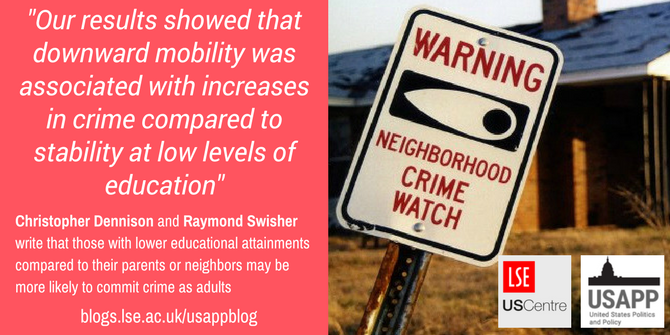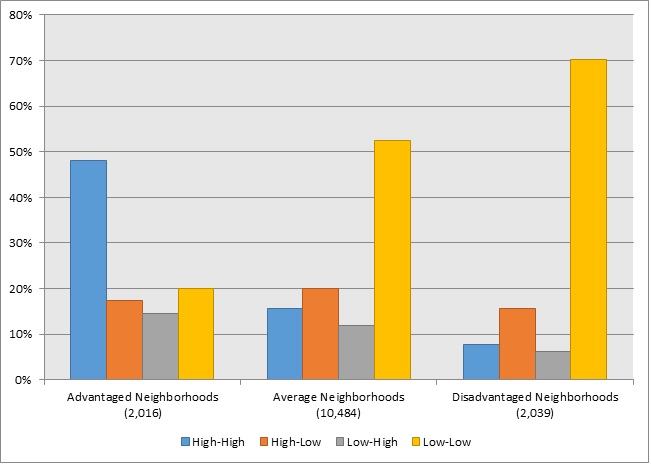
 Criminologists have long considered how perceptions of unfair disadvantage relative to others may lead to crime, but few have examined the simultaneous influence of social comparisons to one’s parents and current neighbors. Christopher Dennison and Raymond Swisher used data from a nationally representative survey to examine the association between intergenerational educational mobility and crime, as well as the role of the type of neighborhood people live in as young adults. They found that downward mobility was associated with increases in crime, and most strongly for those living in more advantaged neighborhoods. They argue that these findings are significant given increasing concerns about downward social mobility and the growing importance of a college degree for economic stability.
Criminologists have long considered how perceptions of unfair disadvantage relative to others may lead to crime, but few have examined the simultaneous influence of social comparisons to one’s parents and current neighbors. Christopher Dennison and Raymond Swisher used data from a nationally representative survey to examine the association between intergenerational educational mobility and crime, as well as the role of the type of neighborhood people live in as young adults. They found that downward mobility was associated with increases in crime, and most strongly for those living in more advantaged neighborhoods. They argue that these findings are significant given increasing concerns about downward social mobility and the growing importance of a college degree for economic stability.
The importance of postsecondary education in the US has never been greater, as college enrollment rates continue to rise, and jobs increasingly require educational training beyond a high school diploma. At the same time as college enrollment grows, including many upwardly mobile first-generation students, increasing inequality suggests that downward educational mobility is also on the rise, with potentially serious consequences for well-being and crime. The concept of relative disadvantage suggests that people often compare their achievements to those of their parents, and when one’s attainments end up being lower than their parents, it represents a loss in status that may lead to crime. However, one’s parents are likely not the sole basis of social comparison. Some studies have found that people also use their current neighbors as the basis of evaluation. Thus, a more thorough understanding of how people assess their attainments should consider comparisons both to the past (parents) and the present (neighbors).
Using data from the National Longitudinal Study of Adolescent to Adult Health (Add Health), we examined the link between educational mobility and crime, and whether this relationship depends on the type of neighborhood in which one is living as a young adult. Our results showed that downward educational mobility was associated with increases in crime, but the effect was weaker in disadvantaged neighborhoods. Moreover, intergenerational stability at high levels of education was associated with decreases in crime, and this relationship was strongest in disadvantaged neighborhoods.

“Neighborhood Watch” by lucianvenutian is licensed under CC BY SA 2.0
We began our study by first distinguishing parents and their adult children who had achieved high educational attainments – a bachelor’s degree or higher – from those with low attainments, i.e., less than a four-year degree. To examine intergenerational educational mobility, we then used this information to group parents and children into four distinct pathways. For example, parents and their children who both achieved less than a bachelor’s degree reflect intergenerational stability at low levels of education (i.e., low-low), whereas children who achieved a bachelor’s degree but whose parents did not reflect upward mobility (i.e., low-high). These are what are commonly called “first-generation” college students. Educational pathways denoting stability at high levels of education (i.e., high-high), as well as downward mobility (i.e., high-low), rounded out our categories. We then examined criminal involvement (based on self-reports of nine criminal behaviors), and as expected, observed the most crime among those in the “high-low” group, whereas the least amount of crime was reported among those in the “low-high” group.
The key part of our analysis is the interplay of educational mobility and neighborhood disadvantage. This requires that there is sufficient variation in the educational experiences of persons living in advantaged or disadvantaged neighborhoods. For example, do we even observe many downwardly mobile persons living in advantaged neighborhoods, or conversely, upwardly mobile persons living in disadvantaged neighborhoods? With this in mind, we next examined the proportion of persons experiencing each educational pathway across neighborhoods of different levels of disadvantage (Figure 1). Not surprisingly, the majority of respondents in disadvantaged neighborhoods are those in the “low-low” pathway (i.e., both they and their parents do not have a college degree). Similarly, nearly 50 percent of respondents who ended up in affluent neighborhoods in adulthood were those in the “high-high” group. Perhaps most notable for our research questions, however, were the downwardly mobile, who were fairly evenly distributed across advantaged, average, and disadvantaged neighborhoods.
Figure 1 – Proportion of Educational Pathways by Neighborhood Disadvantage

Central to our study was the examination of how the criminal consequences associated with educational mobility varied by one’s current neighborhood context. Figure 2 shows the changes in crime associated with educational mobility at different levels of neighborhood disadvantage. As our focus was on college completion and social mobility, we used intergenerational stability at low levels of education (i.e., the low-low group) as the comparison group. Overall, our results showed that downward mobility (i.e., the high-low group) was associated with increases in crime compared to stability at low levels of education. However, the association was weaker as neighborhood disadvantage increased, to the point that there was no meaningful difference in crime between the “high-low” group and the “low-low” group. Conversely, intergenerational stability at high levels of education (i.e., the high-high group) was associated with decreases in crime compared to stability at low educational levels, and these crime-reducing benefits were strongest in the most disadvantaged neighborhoods.
Figure 2 – Effect of Educational Mobility on Crime by Neighborhood Disadvantage

Our study shows how neighborhood disadvantage – a prominent point of reference in studies of relative deprivation – moderates the relationship between educational mobility and crime. In future work, we plan to examine differences in risk-taking behavior and college completion among first-generation (i.e., the “low-high” group) and continuing-generation students (i.e., the “high-high” group). We believe these issues are important given the increased enrollments of first-generation students, the challenges this group faces when trying to persist to completion, as well as the importance of a college degree for admission into the middle-class.
- This article is based on the paper, ‘Postsecondary Education, Neighborhood Disadvantage, and Crime: An Examination of Life Course Relative Deprivation,’ in Crime & Delinquency.
Please read our comments policy before commenting
Note: This article gives the views of the author, and not the position of USAPP– American Politics and Policy, nor of the London School of Economics.
Shortened URL for this post: http://bit.ly/2HaFZEJ
About the authors
 Christopher R. Dennison – University at Buffalo, SUNY
Christopher R. Dennison – University at Buffalo, SUNY
Christopher R. Dennison is an assistant professor in the Department of Sociology at the University at Buffalo, SUNY. Most broadly, his research examines the relationship between intergenerational social mobility and antisocial behavior across the life course. Recent research examines the socioeconomic consequences associated with involvement in the criminal justice system.
 Raymond R. Swisher – Bowling Green State University
Raymond R. Swisher – Bowling Green State University
Raymond R. Swisher is Professor of Sociology at Bowling Green State University. His research focuses on risk factors in the lives of low-income families, such as neighborhood poverty, exposure to violence, and parental incarceration, and their relationships to crime, delinquency, and well-being. Recent research has investigated the relationship between educational mobility, neighborhood mobility, and crime.






